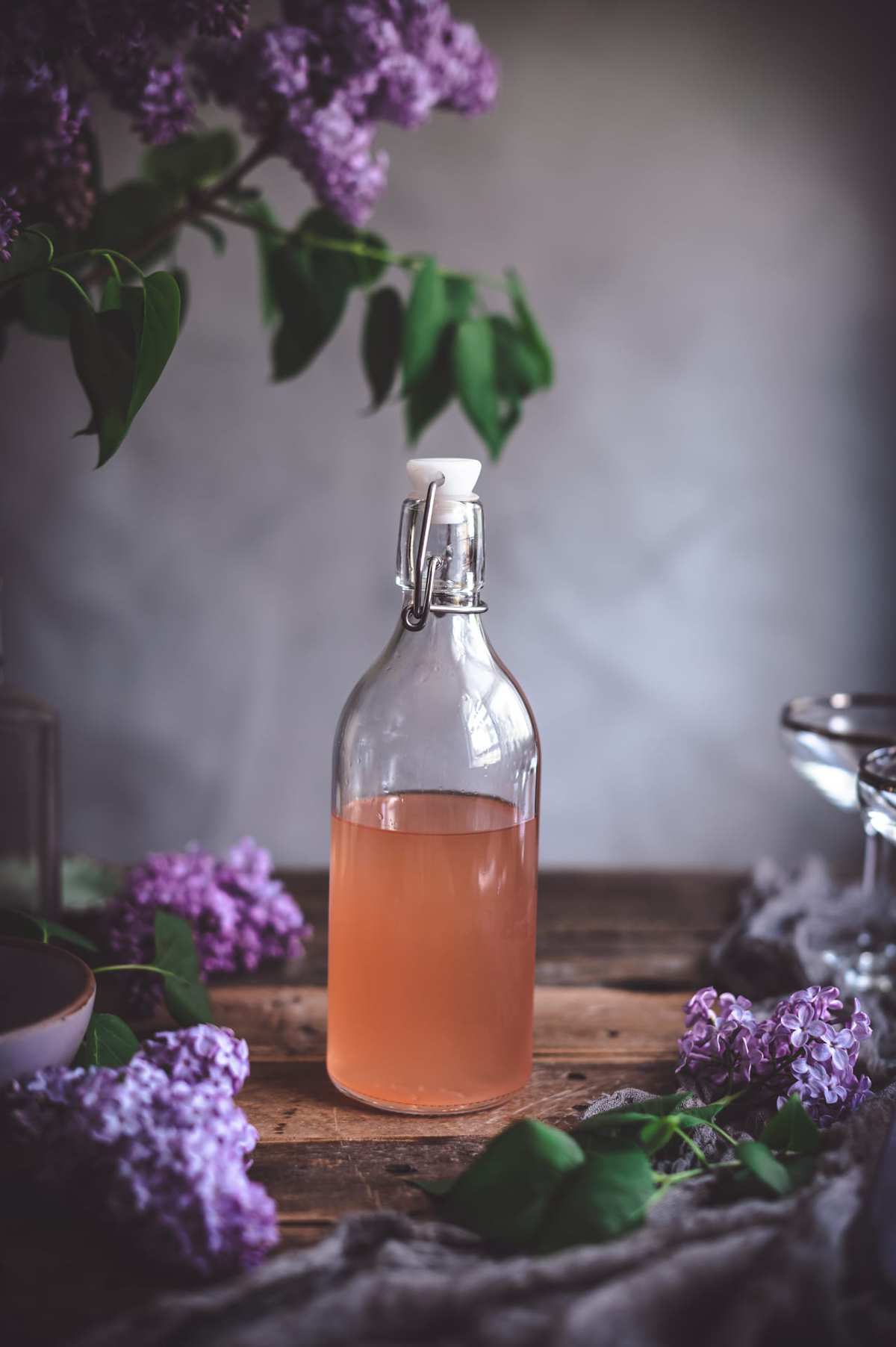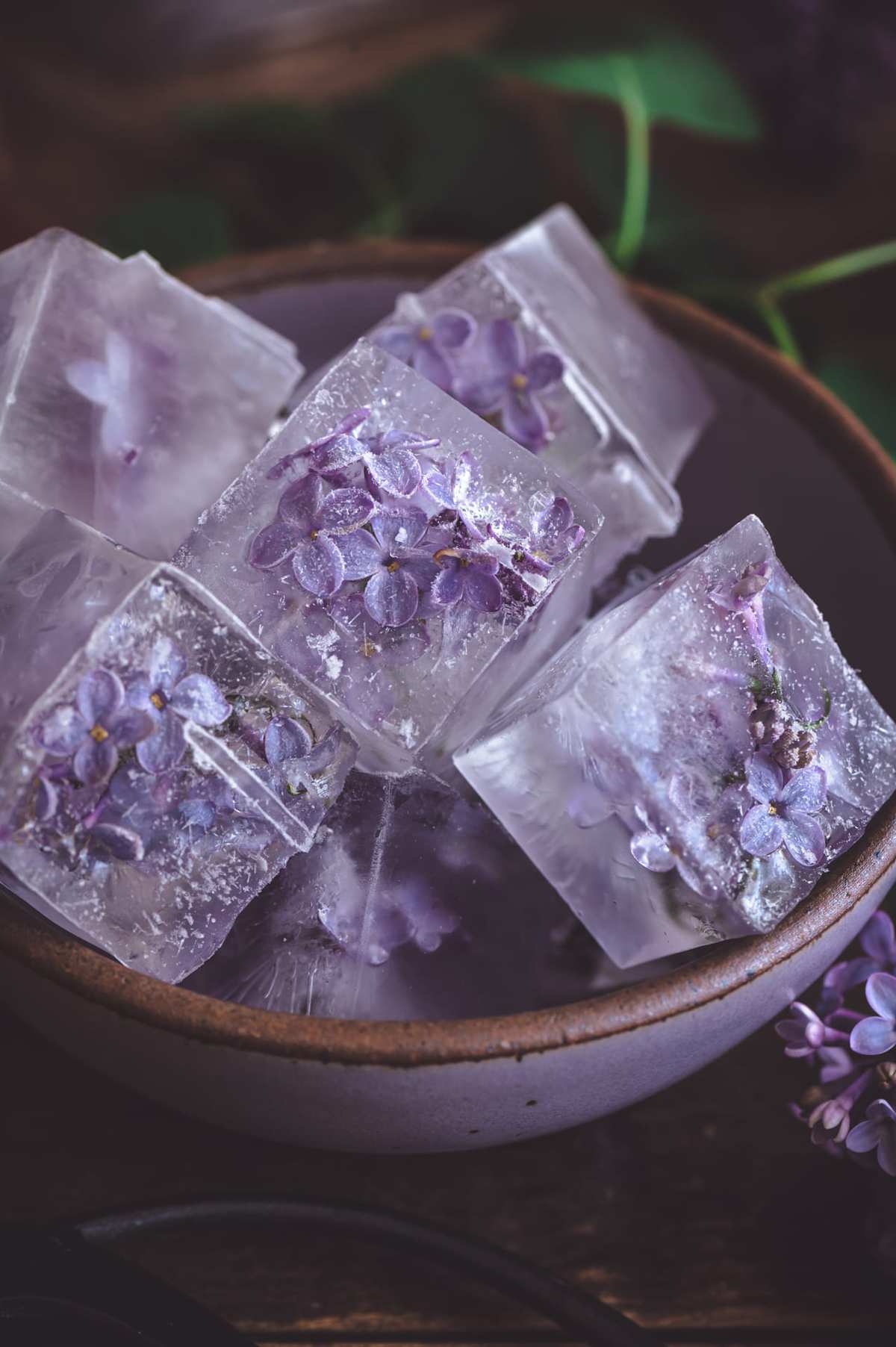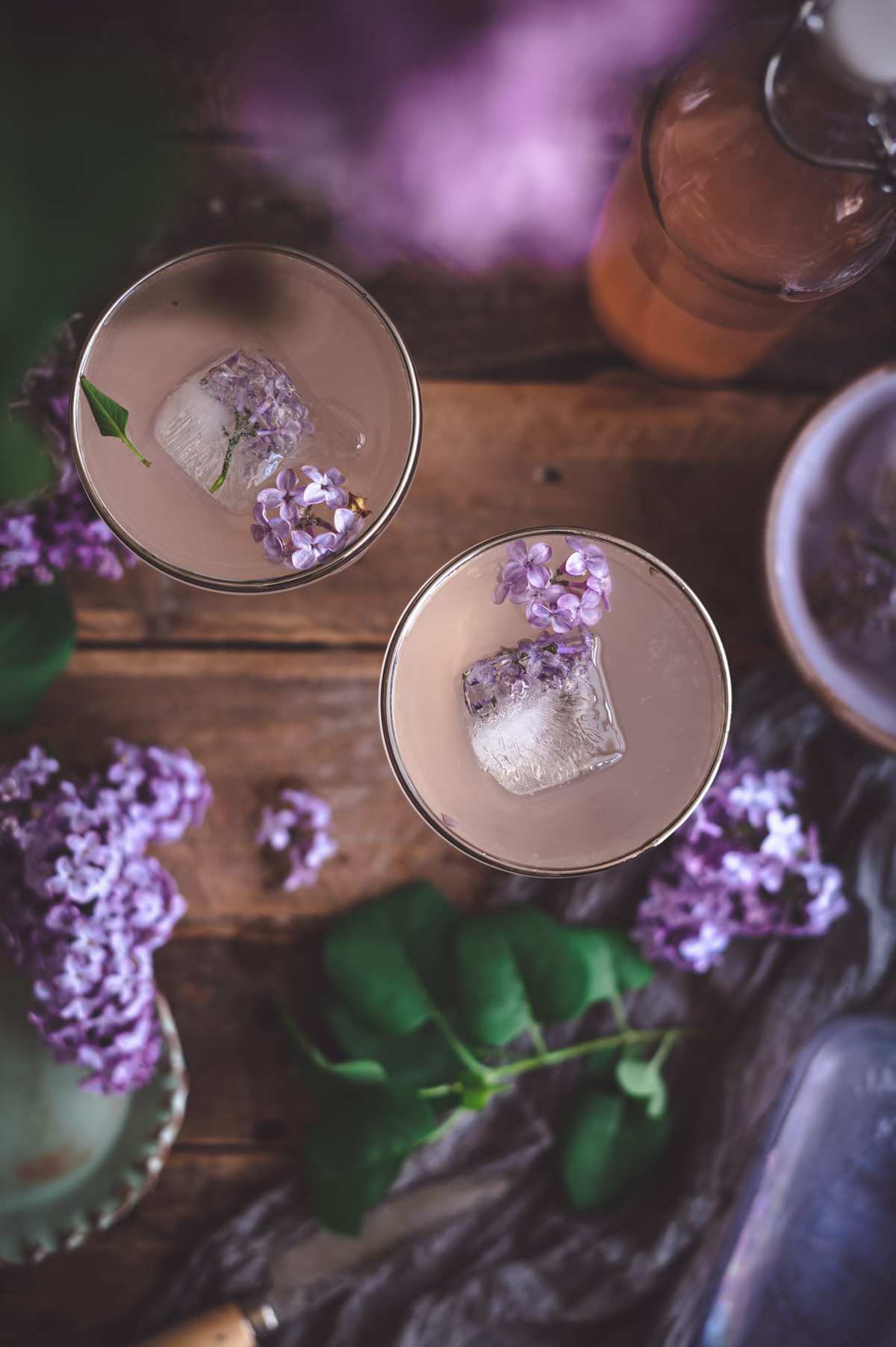Lilac Gin Fizz Cocktail – A Taste of Spring
Lilac season in the northeastern US begins in mid-May and can last through mid-June in some areas. Last week I showed you how to make a simple and easy Lilac Syrup from these sweet-smelling and gorgeous purple blooms. This Lilac Gin Fizz cocktail is perfect for spring celebrations and would be lovely for a midsummer (solstice) celebration in June.

What is Gin Fizz?
“Fizz” is a family of cocktails that are made with acidic juice like lemon or lime and carbonated water. Gin Fizz is a popular variation of fizz cocktails and is one of my favorite drinks to showcase homemade infused syrups like Lilac Syrup. Gin Fizz is traditionally made in a cocktail shaker by the glass but is easily made in a pitcher with ice and stirred as I do in this recipe.

Lilac Ice cubes
Make a batch of lilac ice cubes by simply adding lilac flowers to your ice tray, filling it with water and freezing them until solid. The lilac ice adds an extra special touch to the glass that will wow your guests.


Lilac Gin Fizz FAQs:
To make a non-alcoholic version of the lilac cocktail you can simply omit the gin and add more seltzer/sparkling water.
You can use any unflavored or flavored carbonated water (seltzer, sparkling water, soda water, etc.) The lilac flavor is very delicate so use unflavored seltzer if you would rather not overpower the lilac flavor. I used grapefruit sparkling water as it is what I always have on hand and it was delicious!
No, I made this is a pitcher and just stirred it over ice to chill it. Save the seltzer to add to the glass.
Yes, This recipe can be scaled up easily. Stir the gin, lilac syrup and lemon juice in a pitcher without ice and refrigerate until chilled. This step can be done ahead of time or the night before. Add the seltzer to each glass as you serve it.
You can use a basic simple syrup or any infused simple syrup to make this Gin Fizz recipe. Here are some other edible flower-infused syrup recipes to try: Wild Violet Syrup, Rose Syrup, Elderflower Syrup, Honeysuckle Syrup.
All varieties of Syringa are safe and edible. Please be sure to use only true lilacs of the species Syringa which are part of the olive family, Oleaceae.
Do not use the species Melia azedarach, commonly known as the chinaberry tree, pride of India, bead-tree, Cape lilac, syringa berrytree, Persian lilac, Indian lilac, or white cedar which is a species of deciduous tree in the mahogany family, Meliaceae, and is toxic and not safe to consume. Always be sure to identify any edible flowers and plants correctly before ingesting them.
Lilacs were originally brought to North America by European immigrants and can now be found growing wild in abandoned lots and old gardens. If you don’t have lilacs growing in your own yard you can forage for them in said abandoned areas or if you see them in a neighbor’s yard it never hurts to ask if you can clip a small bouquet. If you do the latter it is nice to offer payment to the owners. Remember that when you clip off lilacs you are pruning them so only take a few stems from each plant. Be mindful of where you are foraging that the area has not been sprayed with pesticides or is in the path of roadway water runoff.

For more warm-weather cocktails check out these recipes:
- Homemade Wild Violet Syrup Recipe
- Strawberry Elderflower Gin Smash
- Sparkling Summer Rose Vodka Soda
- Frozen Watermelon Vodka Limeade Cocktail
- Wild Honeysuckle Strawberry Lemonade
Love this recipe?
If you made my Lilac Gin Fizz recipe I would love to hear your feedback! Please leave a star-rating review of the recipe and let me know what you think in a comment below. This small act is a great way to show your support for the food blogs you read and love. Please tag me in your photos on Instagram so I can see your creations. I might miss it if you only tag me the caption because those notifications fall off quickly, but I can always find it if I’m tagged in the photo itself.


Lilac Gin Fizz Cocktail
Ingredients
- 4 fl. oz. gin 12 cl
- 2 fl. oz lemon juice 6 cl, freshly squeezed
- 1 fl. oz lilac syrup 3 cl
- 6 fl. oz carbonated water 18 cl
Garnish:
- lilac ice cubes
- lilac flowers
Instructions
- Add the gin, lemon juice and lilac syrup to a pitcher with a handful of ice. Stir everything until combined with a long spoon.
- Pour into 2 cocktail glasses or tumblers and top with ice-cold carbonated water.
- Optionally add lilac ice cubes and lilac flowers to garnish.
Video
Notes
- The recipe can be halved to make one serving and made in a cocktail shaker filled with ice instead of a pitcher.
- The recipe can be scaled up to make for a group of people. Add the carbonated water to each glass as you serve it.
- Note of Caution: Please be sure to use only true lilacs of the species Syringa which are part of the olive family, Oleaceae. Do not use the species Melia azedarach, commonly known as the chinaberry tree, pride of India, bead-tree, Cape lilac, syringa berrytree, Persian lilac, Indian lilac, or white cedar which is a species of deciduous tree in the mahogany family, Meliaceae, and is toxic and not safe to consume. All varieties of Syringa are safe and edible. Always be sure to identify any edible flowers and plants correctly before ingesting them. Make sure to know the source of your lilacs and that they are unsprayed. Avoid using lilacs growing directly on roadsides where they drink up polluted runoff water. Also, be mindful to not over-overharvest the plant. You are pruning the plant so only take a few stems from each plant.
Nutrition
Wearing the Garden Shirt from So Elly, designed by my dear friend Julie Stephenson.



Liz
My new favorite cocktail!
Kaity Farrell
test
G Dawg
Please be careful to use only common lilacs to make your simple syrup! I did not know and used Persian lilacs which are toxic and had 2 days of severe gastro upset!! No need to the author for not knowing either but hopefully they put a warning to help get the word out there.
Kaity Farrell
Thank you for sharing this and I’m sorry you had that experience. Please be sure to use only true lilacs of the species Syringa which are part of the olive family, Oleaceae. I believe you used Melia azedarach, commonly known as the chinaberry tree, which is a species of deciduous tree in the mahogany family, Meliaceae. All varieties of Syringa are safe and edible.
Kaity Farrell
Thank you for sharing this and I’m sorry you had that experience. Please be sure to use only true lilacs of the species Syringa which are part of the olive family, Oleaceae. I believe you used Melia azedarach, commonly known as the chinaberry tree, which is a species of deciduous tree in the mahogany family, Meliaceae. All varieties of Syringa are safe and edible.